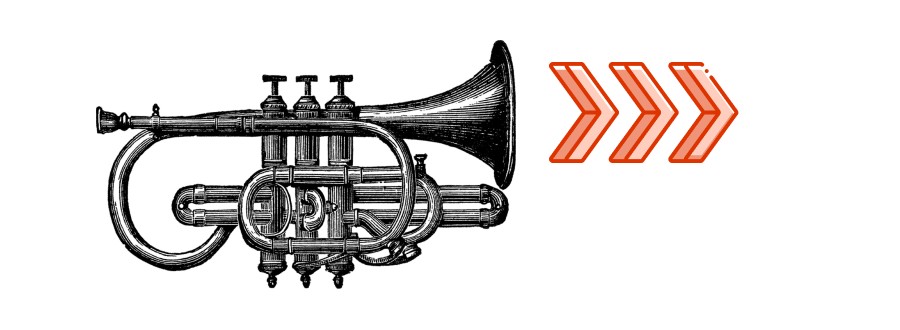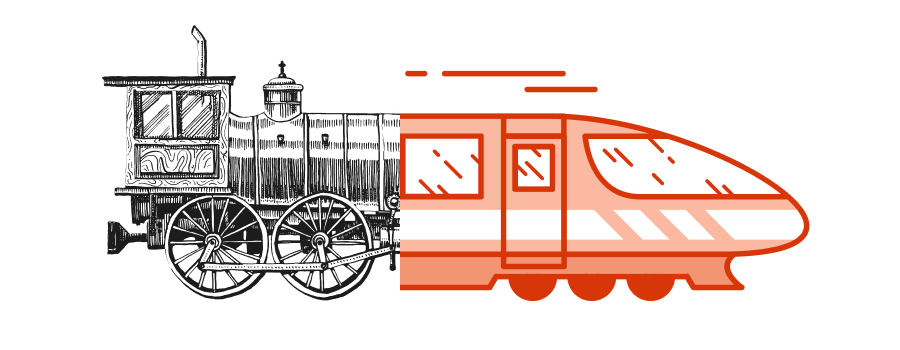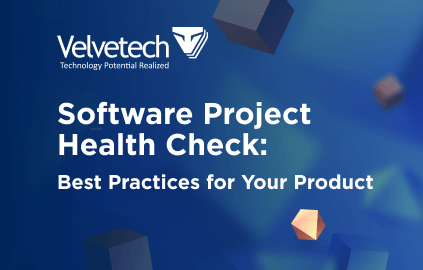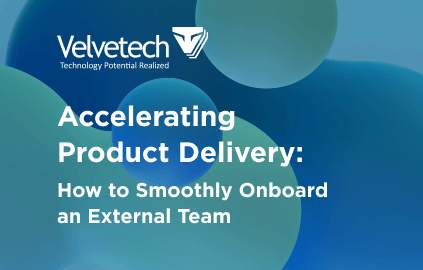Imagine you run a century-old family business worth millions, and the hard-earned algorithms — the ones that power your 56 greenhouses — are trapped in a 30-year-old application. A legacy system, some say.
According to Forbes, 44% of CXOs consider legacy systems as one of the core barriers on their path to achieving a competitive edge. That is mostly because the outdated app could be written with a programming language that lost support over a decade ago. Or, the team that built it is long gone.
In general, your old app may work only on Windows machines. That is to say, you can’t access it from your phone or browser. It sits on an unprotected server. And you keep asking, “How much longer can this setup work?”
In theory, you are good to last for another thirty years: those algorithms have gotten you through almost half a century and made your business a success. But in practice, your competition will probably oust you by then. So how do you deal with this?
Read on to learn how we helped this plant-growing company and other businesses deal with digital transformation and make sense of legacy system modernization.
What Is a Legacy System?

It’s not like there is a strict dictionary definition of a legacy system or software. Still, you know when you’re dealing with one, right?
As a CIO, VP of Technology, or CTO, you’ve probably inherited a software platform that serves as the backbone for nearly all business processes at your place. And you know it’s legacy by definition because you did not architect it — your predecessors did.
But what if you are a CEO or a Product Executive trying to figure out if your operations rely on an old infrastructure? Well, the first sign is you and your employees become grumpy about using the software. But let’s look at some other symptoms that indicate it’s time to modernize legacy systems.
Legacy System Symptoms
Symptoms |
Impact |
|---|---|
| Software hinders productivity and innovation | Your app can’t handle new market demands, upscale offerings, or optimize processes. |
| No one owns the system | All issues and bugs, even if mission-critical, remain unresolved as there is no responsible department for updates. |
| Customer support cost escalates all of a sudden | You spend a fortune on maintenance but get no tangible results. Your product needs a critical review. |
| The vendor no longer provides support | It leaves no room to fix issues, improve efficiency, or enhance software security. |
| You deal with a skill shortage | The industry is changing, and resources needed to support your system may become scarce and costly. |
| Training investment falls short | You heavily invest in training, yet expectations remain unachievable. |
Based on the above, our greenhouse-owning client was right to identify their case as dealing with a legacy system. At the same time, they were very particular about their needs, wisely not seeking to over-optimize their solution.
Read more about Plant Production Legacy System Migration
Meanwhile, you should be aware of false positives: something that looks characteristic of a typical legacy system, but not doesn’t in fact make it one.
Legacy System False Positives
-
Outdated UI
Even though conversations about old app modernization often start with discussing UI, it should not be the main reason to drive digital transformation.
Case in point: the company operating greenhouses would be happy to continue using its legacy system. Despite the 80’s UI, the software had been helping the business to rake in millions of profit for over 30 years. Alas, the lack of modern design was only one of the system’s shortcomings.
-
Not in the cloud
I’m trodding a thin line here, but the cloud is not always great or, better, it’s not always a cloud. When IT chatterboxes are lecturing enterprises on the cloud, they often mean SaaS solutions accessible from a browser. The thing is you can have an on-premise server (like a private cloud) running your system and access it via a browser too.
-
Not on mobile
Mobile is also not always a must-have element of a modern system. I have worked at six successful software development companies, and none of them relied on a mobile app for their day-to-day activities.
At the same time, mobile apps can drastically improve old infrastructures and empower field workers, as was the case when we developed a warehouse management app.
As you understand, the efficacy of extending a legacy system into mobile apps depends on a business’s specifics. For instance, the plant-growing company from our example did not need a mobile app as there were no relevant use cases.
Project Health Check
Learn the actionable steps to keep your software project on the right track, aligned with your initial goals and designated priorities.
Why Begin Legacy Software Modernization

Now that we’ve discussed the symptoms and false positives of legacy systems, let’s iron out why your business might need to embrace modernization.
After all, such fundamental projects rarely go unnoticed for the company’s budget, and you need to line up all the facts and figures to convince stakeholders and investors.
Outrun the Competition
Well-run companies are always looking for ways to run their business more effectively. And in the age of digital disruption, when innovative technologies like blockchain, IoT, and artificial intelligence abound, this pace only intensifies.
- Release superior products to market or update products and services faster.
- Secure your IT infrastructure by implementing the latest cybersecurity best practices.
- Increase your employees’ morale and customers’ satisfaction with better products.
- Turn your legacy solution into a future-proof one by making it available for integration via APIs.
Case in point: One of America’s Best Executive Recruiting Firms has been growing its database of candidates 3x faster after Velvetech completed a legacy app modernization project for them.
Cut Hidden Costs
One of the obvious reasons to modernize your software is to cut hidden costs. Let’s take a quick look at the most common factors that come with significant costs and challenges:
Factor |
Challenge |
|---|---|
| Maintenance and support | Frequent updates may lead to conflicts, thus requiring much time and money to fix. In the long run, it can cost way more than the initial development process. |
| Integration | Connecting a legacy system with a third-party tool is challenging, with no guarantee of smooth operation. |
| Compliance | Meeting industry regulations can be costly and tough, yet it’s the only way to avoid hefty fines and maintain trustworthiness. |
| Security | On average, a data breach costs $4.88 million globally. This makes security a major risk for businesses, especially those with old solutions. |
| Agility and efficiency | While modern technologies can significantly boost product efficiency and reduce operational costs, old software isn’t flexible enough to adapt to innovations. |
Obviously, an outdated solution risks being kicked out of the competitive market. Meanwhile, with the right legacy system modernization approach, you may both cut costs and keep your product relevant in the marketplace longer, even if it’s not the most innovative one.
In particular, you may consider the following steps to optimize your budget:
- Package more into your offering for the same price point by optimizing business processes.
- Regroup resources to make sure everyone is working on adding value.
- Spend less on staff training.
Case in point: A healthcare consulting firm reduced its operational costs by 30 percent after Velvetech modernized their old software and migrated it to a new CRM platform.
Address Organizational Changes
It’s quite often the case when companies need to embrace new processes due to an acquisition or a merger. This environment is probably the optimal position for newly appointed CEOs or VPs of Technology to take charge and spearhead the initiative of legacy system replacement strategy.
- Remove inefficiencies and optimize workflows
- Build on the strengths of the existing systems
- Align with changing market demands
Case in point: After IncreMedical acquired Medadept, Velvetech helped them extend their suite of apps with mHealth solutions so they could target a wider audience and enhance user experience.
Legacy System Modernization Strategies

It’s not like there’s a textbook out there prescribing specific procedures for embracing legacy modernization at your firm. And you’re probably aware of the reason: each situation is unique. Still, we can single out several major approaches. Among them, you can find the right application modernization strategy to address your situation.
Replace with a New System
A radical overhaul of the company’s IT infrastructure and underlying software is the most common approach to the modernization of legacy applications. And it’s pretty evident too: rebuild the whole thing from the ground up.
Benefits:
- Offers unlimited modernization potential
- Invites to rethink and optimize business processes
- Ensures substantial gains on ROI and other key metrics over the short and long-term
Risks:
- Takes longer to implement
- Requires significant investment
- Suggests running of two systems until the final switch
The replacement strategy was the one we applied for the century-old family business operating greenhouses. Yet, we left the time-tested algorithms intact, taking them and putting into a modern, secure cloud application.
You can also find it interesting how Velvetech helped a telesales company Migrate from an In-House Legacy CRM System
Rebuild Gradually
Another proven way to modernize your software is the app-by-app approach. In this scenario, you pick the most ROI-effective applications in the legacy solution and rebuild them one by one.
Benefits:
- Moderate modernization potential as remaining legacy parts will be holding back
- Requires less management and investment resources (compared to total system revamp)
- Makes the min negative impact on running business operations
Risks:
- May involve too many integrations with the existing legacy system to ensure business continuity
- Does not work well when several components are being rebuilt simultaneously
That is exactly how we managed an epic insurance system overhaul for Insureon — Inc. 500’s #1 fastest-growing insurance company.
Reuse
And the least invasive legacy system modernization approach is, of course, to reuse the existing IT infrastructure as much as possible. Here is how you can get there:
-
Encapsulate
The legacy software remains the same, and some of its parts become available for integration with other systems or applications via an API layer.
-
Rehost / Replatform
The legacy system gets migrated to a new physical or virtual server. That’s when old software ends up in the cloud and becomes more accessible, but carries over its other limitations. This scenario may involve slight changes to make sure your solution runs error-free on a new platform.
-
Refactor / Rearchitect
With this scenario, a legacy system’s codebase gets substantial updates and modifications to speed up its performance and remove technical debt. But its core functionality remains the same.
Benefits:
- Lower cost
- Faster to implement compared to other modernization methods
Risks:
- Minimum ROI value
Learn more: How to Update Legacy Software According to McKinsey, Gartner, and Deloitte
Best Practices for Legacy Software Modernization

As per our experience, legacy system modernization projects most often happen in the insurance, finance, energy, and healthcare industries.
#1 Legacy Software Modernization Starts with People
Legacy system modernization is a perfect opportunity to adapt business processes to the changing reality. But remember that it’s employees who manage operations at your company. So get buy-in from across the board.
Expanding a Team
Watch our webinar to unveil the tricks of onboarding a tech partner and incorporating it into the process to foster your product delivery.
#2 Modernize Parts that Add Most Value First
Take a strategic approach — it makes no sense to revamp everything at once. Instead, start with the pieces that will make the most substantial impact on the ROI.
#3 Build to Scale
Your legacy applications must remain current for as long as possible. So you should architect with this goal in mind. If your legacy software is a monolithic system, break it into independent microservices, transfer them to the cloud, and envision mobile apps to support its operations.
#4 Implement Continuous Integration and Delivery
CI/CD are indispensable components of ever-fresh platforms. As you modernize your legacy system, make sure to integrate DevOps services and best practices into the process. This way, your no-longer-legacy system will be getting continuous improvements.
#5 Take Advantage of IoT, AI, and other Value-Driving Tech
As you start your legacy modernization process, explore opportunities to add new features and inject modern technologies like IoT, AI, and AR or VR to make your solution efficient and competitive.
Emerging Trends in Legacy System Modernization

Having discussed several strategies on how to modernize your legacy system, you probably have some ideas on where to start. To help make the process even smoother, let’s skim through the top trends before wrapping up.
Update Code
Outdated code opens the door to all sorts of issues, from higher risks of cyberattacks to limiting your product’s functionality. Typically, code relies on third-party libraries, so it’s crucial to ensure they are updated regularly. If not, consider switching to a provider that offers ongoing support and upgrades. Otherwise, your software will become vulnerable and inefficient.
Utilize Containers
Next up is containerization. At their core, container technologies include everything needed for your app’s seamless performance from code to configuration files. This makes them an almost irreplaceable element for IT companies. As such, businesses can have peace of mind knowing their products run smoothly across different environments.
Leverage AI-Chatbots
AI-driven chatbots can be a real helping hand in modernizing your app. And, here’s why: Compared to traditional chatbots, which need large databases to provide clear answers to queries, AI-driven assistants operate with limited information. This is because AI algorithms learn from past data and the queries they resolve.
Hence, even if you provide an AI chatbot with clear yet short information about your product, it can still provide relevant responses based on its database.
Conduct A/B Testing
Before starting to modernize your app, you should identify which features require critical changes. One of the simplest yet most effective ways to get there is by conducting A/B testing.
This process is quite simple: you give products with different features to two groups, and based on their feedback, you can determine which ones will be the best match for your software.
Time to Review Your Legacy System?
Do you currently rely on a legacy system that could benefit from modernization? Are you not sure how to approach this task? Maybe you’re struggling to justify the investment in modernizing your product and worry that the newly updated system will become a legacy solution again in the future.
Reach out to us today, and we’ll help you find and implement the best legacy software modernization strategy. Like we already did for so many successful companies.
































